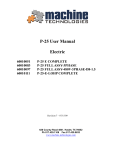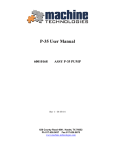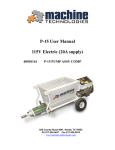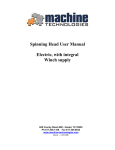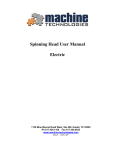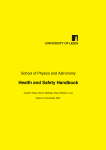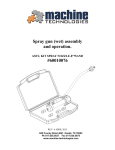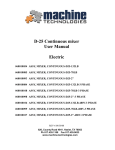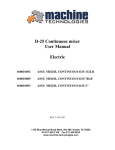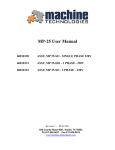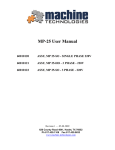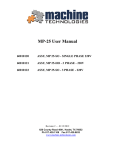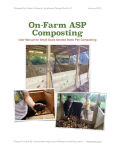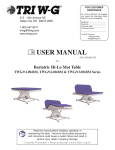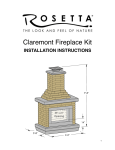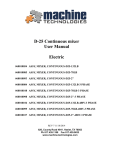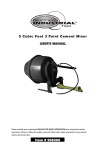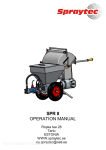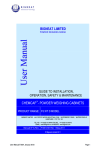Download P-25 User Manual Hydraulic and Electric
Transcript
P-25 User Manual Hydraulic and Electric Revision 5 – 10/11/07 1130 Blue Mound Road West, Ste 400. Haslet, TX 76052 Ph 817.439.1108 Fax 817.439.0633 www.machine-technologies.com Dear Customer, Before starting this machine please complete the following; Machine Date of purchase………………………………….. Machine serial number……………………………………… Please read the following information contained within this manual and fully familiarize yourself with the equipment. Page 1 Contents Page Section 1 - General Safety information........................................................................... 3 Danger............................................................................................................................. 3 Section 2 - Machine Description ...................................................................................... 4 Function.......................................................................................................................... 4 Machine illustrations..................................................................................................... 5 Machine ....................................................................................................................... 5 Hopper unit................................................................................................................. 6 Front and rear seal location ...................................................................................... 7 Pump Unit ................................................................................................................... 8 Drive unit .................................................................................................................... 9 Electronic Drive module .......................................................................................... 10 Hydraulic Drive unit ................................................................................................ 12 Drive Shaft with bridge breakers ........................................................................... 13 Section 3 – Transportation and positioning.................................................................. 14 Section 4 – Machine set up ............................................................................................. 15 Unpacking..................................................................................................................... 15 Machine assembly........................................................................................................ 16 Electrical connections – electric version only............................................................ 19 Section 5 – Machine operation / speed setting.............................................................. 21 General notes for operation ........................................................................................ 21 Section 6 – Simple maintenance..................................................................................... 22 Section 7 – Notes on wear of rotor stator pump unit................................................... 23 Wear issues................................................................................................................... 23 Dry running of a rotor-stator pump ....................................................................... 23 Dry running of rotor-stator pump due to dry pockets in mixed material .......... 23 LIMITED WARRANTY POLICY .............................................................................. 24 Page 2 Section 1 - General Safety information Danger Follow these instructions very carefully, in order to avoid injury to yourself or others. Hydraulic powered machine. Always ensure that all power to the machine has been turned off and isolated, ie. The hydraulic power pack must be turned off and prevented from being started before ANY maintenance / repair work is carried out on the machine. Electrically powered machine. Always ensure that all power to the machine has been turned off and isolated before ANY maintenance / repair work is carried out on the machine. Ensure that all guards are correctly fitted before starting or attempting to operate the machine. Ensure that all fasteners are present and correctly fitted before attempting to start or operate the machine. Ensure that the pump unit is correctly fastened to the front of the hopper unit of the machine, and free of damage before attempting to start or operate the machine. Ensure that the hydraulic motor, the flange and the hydraulic hoses are correctly fitted and free from damage before attempting to start or operate the machine. The P-25 pump unit can produce high pressures, high torques and can use high voltages. Care must be taken by authorized persons when using and working with this machine. Page 3 Section 2 - Machine Description Function The machine has a drive motor, that turns a drive shaft within a material hopper that in turn feeds a progressive cavity rotor stator pump unit that delivers the material from the hopper to the dispense head via a material hose / hoses. The machine is driven by either an electric motor powered by 220VAC 3 phase 50/60Hz, via an electronic variable speed inverter supplied by two phase 220VAC 50/60 Hz OR a remotely supplied hydraulic high pressure hydraulic supply into a hydraulic motor. Both style of drives transmit their rotary action through a drive shaft equipped with bridge breakers, which help to mix and convey the material from the hopper towards the pump unit. The pump unit is a progressive cavity pump unit comprising of a helical rotating “rotor” with the rubber lined “stator”. As material is drawn / fed into the pump unit it is forced through a series of cavities that deform, causing the material to be moved from the hopper towards the outlet. Once the material has reached the outlet it is guided through an output flange assembly, into the dispense hose through to the hose outlet, where typically a spray nozzle is attached allowing, with the assistance of an auxiliary air supply, the material to be “sprayed” on to the substrate. A number of different devices can be fitted to the outlet of the tube for different means of application. For details of these different devices please contact your supplier of Machine-Technologies equipment or Machine-Technologies directly. Page 4 Machine illustrations Machine 1 – Hopper unit bridge breakers 2 – Pump unit 3 – Drive unit (elec shown) Page 5 4 – Drive shaft with Hopper unit Page 6 Front and rear seal location Page 7 Pump Unit “D” pump series – Typical delivery 106 ft³/hr @ 400 RPM “D” – Pump 1 – “D”-Rotor 2 – “D” Stator 3 – Mount flange 4 – tie rod 6 – Output flange 7 – Washer 8 – Pump seal. 5 – Nut **Outputs are theoretical and typically 25% higher than seen in practice. Outputs are also subject to material type, moisture levels, application method and as such testing should be performed to establish suitability. Page 8 Drive unit The machine is supplied with either an electric motor drive, or a Hydraulic motor drive. Both methods of drive are compatible with both pump units. Electric Drive unit 1 – Drive/Haul bracket 4 – Compression ring 8 – Key 2 – Grease seal 5 – Location dowel 9 –Bolt Note – GREASE ON A DAILY BASIS. Page 9 3 - Motor flange 6 – Electric motor 10-Lock washer 7 – Set Screw 11-Grease sert Electronic Drive module The electronic Drive module comprises of a variable speed frequency inverter, allowing the use of 220VAC two phase to run the high torque 3 Phase gear motor. The unit is rated at 7.5 HP providing plenty of power to run the P-25 unit. The module is supplied with an input plug allowing immediate wiring into your own 220VAC 2 phase supply (Must be carried out by an approved installer). The motor is supplied with a pre-wired plug that fits into the 3 Phase outlet of the module. The module has a main power isolator, a combine stop / start switch, a reverse switch, a speed control potentiometer, internal breakers, for each input phase, a large capacity cooling fan in addition to the fan fitted to the inverter, and a remote socket, providing the optional capability for remote operation. A carrying handle is provided on the top of the module for convenient re-location around the job site. 1-Mains isolator 2-Start/Stop buttons 3-FWD/REV switch 4-Speed control 5-Remote plug/connector 6- 3 ph power out connector Page 10 7-fan filter covers 8-Single phase mains power inlet Page 11 9-Inverter drive Hydraulic Drive unit 1 – Motor flange 2 – Grease seal 3 – Compression ring 4 – Location dowel 5 –Drive bracket 6 – Motor plate 7 – Set screw 8 – Grease sert 9 – Hydraulic motor 10 –Motor fixing bolt 11 –Plate fixing bolt 12 – split washer Note – GREASE ON A DAILY BASIS Page 12 Drive Shaft with bridge breakers The drive shaft couples the motor drive to the pump unit, and allows one to turn the other. The drive is equipped with bridge breakers, which prevent “bridges” being formed through the material in the hopper and at the same time move material towards the inlet of the pump unit. 1 – Drive shaft 2 – Drive paddle 3 – Bridge breaker Page 13 Section 3 – Transportation and positioning The machine is typically manually transported around the job site using the two carrying handles, and the wheels in a similar manner to a wheelbarrow. The handles swing vertically down and out of the way when not in use. If the machine is to be permanently positioned then they can be removed and stored for later replacement. If the machine is being transported between sites, normally the pump unit will have been removed from the front of the machine, due to cleaning between jobs, providing access for lifting hooks around axle on each side of the machine and from the front of the unit. The illustration of the machine above refers to the electrical version, if hydraulics are being used then attention will have to be taken towards the two hydraulic hoses from the power unit to the machine itself. Page 14 Section 4 – Machine set up Unpacking Remove the safety grid from the top of the machine by removing the 4 bolts, clips and washers. Remove the pump unit, pump wedges and the breaker bar from the hopper. Consult the final inspection record supplied in the packing for details of your machine and the items checked prior to shipment. Keep this document for your records. Page 15 Machine assembly Ensure that the motor wedges are secured and in place. Assemble the breaker bar into the hopper and engage one of the flat ends into the slot in the drive / hauling bracket. Page 16 Rotate the drive shaft by hand until the other flat end of the shaft aligns with the approximate position of the slot in the end of the rotor in the pump unit. Lubricate the “O” ring seal and slid the pump unit towards the hopper, over the location shafts, locating the drive shaft into the end of the slot in the pump unit. Page 17 Ease the pump assembly into position, then assemble the two wedges into the slots. Manipulate the pump unit and the wedges until the pump flange is within 1/8” of the hopper flange, then drive the wedges into position until both flange faces are flush. Note: the drive shaft will become tight between the two drive slots during static assembly. Once the unit has been running the compressive force will be reduced or eliminated to within working limits. During pumping the compression will be present, during reverse the compression will be relieved. Important Replace the safety grid back onto the top of the hopper and secure using the 4 clips, bolts and washers. Operation of this machinery without the grid in place is prohibited. Page 18 Electrical connections – electric version only 1. Ensure that there are no power connections to the Electronic drive module. 2. Site the drive module with 6’ of the P-25 unit, as this is the fitted power lead length from the electric drive motor to the connecting plug. 3. Obtain a suitable connection lead for single phase 220VAC feed to the drive module. The length must be such that the delivered voltage to the drive must be 220VAC, and capable of supplying 30A on each leg / phase. Turn the breakers OFF in the box, and remove it from the bus bar to ensure that no voltage exists on the cables. 4. Make the connection between the drive module and the main distribution box, using the supplied electric plug and your supplied cable. Ensure that the Earth is connected, as well as the two 110 VAC phases. 5. Connect the plug to the drive module, and ensure that the drive module rotary isolator switch is turned OFF. 6. Replace the breakers into the distribution box, onto the bus bar and turn them ON. 7. Turn the drive module isolator to ON, and listen for the cooling fan to turn on. Page 19 The following must be conducted by a supervisor or a qualified individual experienced in electro-mechanical equipment. Ensure that there are no persons close to the machine. Ensure that there are no obstructions in or around the machine. Turn the speed control knob fully clockwise. 8. Press the start button and observe the machine to turn the drive shaft and in turn the pump unit. PRESS THE STOP button, within 5 seconds or damage will result to the pump unit. 9. Turn the direction switch from FWD to REV, and hold in position, as it is spring returned, to prevent excessive reverse running.. 10. Press the start button and observe the machine to turn the drive shaft and in turn the pump unit, in reverse. PRESS THE STOP button within 5 seconds, or damage will result to the pump unit. Note the unit may be equipped with an initial motor reverse timer control, in which case when in FWD direction the motor will run in reverse until the timer times out, then the unit will function in the normal manner. The reverse function it to help “break” loose the rotor within the pump unit. 11. The machine is now ready for use, by trained and qualified operators. Page 20 Section 5 – Machine operation / speed setting The following are to be completed by trained and experienced persons, familiar with the pumping system provided. 1. Connect a hose to the output coupler on the end of the pump unit. 2. Fill the P-25 hopper with water and a suitable lubricant. 3. Place the discharge end of the hose, into the hopper, making sure that the end cannot come into contact with the moving parts inside the hopper. 4. Turn on the machine in the FWD direction and observe fluid to be displaced from the hopper through the tube and then back to the hopper, in a recirculatory manner. 5. Using a suitable collection vessel and a stop watch, time the volume discharged in a given period. Convert this amount displaced into gallons / minute. Compare this figure with the required figure and adjust the speed accordingly. Do not run the machine with water and lubricant for more than five minutes at a time or damage will result to the pump unit. General notes for operation • • • • • • • • • • • • • Grease hauling bracket seal daily, with water resistant, corrosion inhibited grease. For starting the pump, Ensure that the speed control is at minimum, and direction control are set to forward. Turn main power switch on. Push start button. Adjust speed to desired output. Do not let hopper run dry while pump is running. To stop machine push the stop button. If a hose plugs while pumping, reverse direction on pump to relieve line pressure. Never point hose towards personnel when pump is working. When cleaning the pump, do not remove grate while pump is running. Wash out hopper with water and let it run out of the hose. When the hopper is clean run foam balls through hose with clean water. Do not spray water on or in control box. Control box should be wiped down with a damp rag. If access is required in to the hopper, disconnect power source before removing grate. Pump can be disassembled by removing wedges, this facilitates easier transport and final clean up. Pump is supplied with an adjustable stator. The sleeve can be tightened to bring working pressure back to normal range as the stator wears down. This should be done in small increments. Over tightening the stator will cause premature wear and heat up material. Always check hoses and cords for wear. The unit runs on high voltage and is capable of high pressures in the hoses. Page 21 Section 6 – Simple maintenance The P-25 pump unit is very simple to maintain. By far the biggest part of maintenance of the P-25 machine is cleaning after a job. Failure to clean properly after use will damage seals, paint, and moving parts due to material build up causing wear. Pay particular attention, when cleaning, to the seals between the Rotor stator flange and the flange on the front of the hopper, to the seal between the motor mounting flange and the rear of the hopper, to the seal around the drive / hauling bracket fixed to the drive flange at the rear of the machine. Ensure that the seal between the hauling bracket and the motor is greased each day, with a water resistant, corrosion inhibiting grease. Grease until a small amount of grease can be seen “oozing” from around the hauling bracket Page 22 Section 7 – Notes on wear of rotor stator pump unit Wear issues Dry running of a rotor-stator pump A screw pump can only work reliably if there is adequate and appropriate lubrication. The lubricant produces sliding friction between the rotor and the stator. If this lubricating film is damaged, high temperatures are reached and the elastomer wears within a very short time. Even if dry running lasts only a few seconds with new parts, the effect resembles that of a wheel spin on a car tire, dramatically affecting length of service. Dry running of rotor-stator pump due to dry pockets in mixed material It is possible for pockets of material to pass through the pump which are dry inside, if mixing is inadequate or in the case of some problematic materials. Since these pockets are partially squashed between rotor und inside of stator, some degree of dry running ensues, which interrupts the lubrication film between rotor and stator, with severe, detrimental effect on service life. Page 23 LIMITED WARRANTY POLICY Machine Technologies warrants each of its new machines to be free of defects in material and workmanship under normal use and services for a period of one (1) year from the date of delivery. The warranty is issued ONLY to the INITIAL USER. The warranty period begins when the product is delivered to the initial user or when first put into service, whichever occurs first. Said warranty is void if the machine is subject to misuse, neglect, accident or abuse. Machine Technologies’ obligation under this warranty is limited to correcting without charge, at its warehouse, any parts or parts thereof which shall be returned to its warehouse, transportation/shipping prepaid and upon Machine Technologies’ examination proves to have been originally defective. Correction of such defects by repair or replacement shall constitute fulfillment of all obligations to the initial user. This warranty does not include labor or transportation charges unless specifically identified and authorized in writing by Machine Technologies. Nor does the warranty apply to any unit upon which repairs or unauthorized alterations have been made. The warranty does not apply to normal maintenance service or to normal replacement of certain machine parts which are subject to normal wear (including but not limited to pins, bushings, rotors, stators, hoses, spray caps, spray nozzles, mixing shafts, shaft couplings and connectors, dosing shafts, pump shafts, filter elements and tires). THIS IS A LIMITED WARRANTY AND IS IN LIEU OF ANY OTHER WARRANTIES, EXPRESSED OR IMPLIED, INCLUDING ANY WARRANTY OF MERCHANTABILITY OF FITNESS FOR A PARTICULAR PURPOSE. In no event shall Machine Technologies be made liable for incidental, general or consequential damage, loss or any expense directly or indirectly related and resulting from use or lack of use caused by delay in delivery, parts failure, or any other causes associated with the product use. No person, firm or corporation is authorized to assume for Machine Technologies any other liability in connection with the sale of Machine Technologies products. Page 24


























